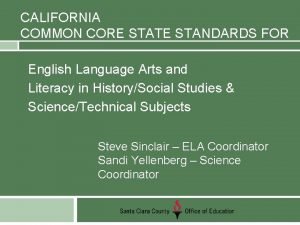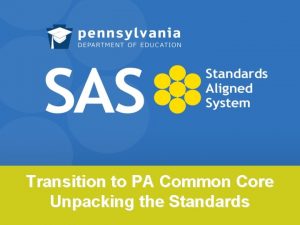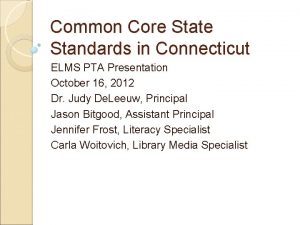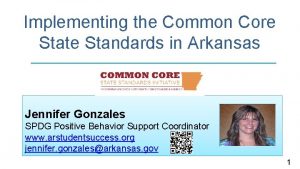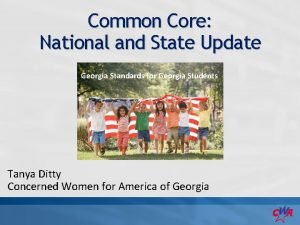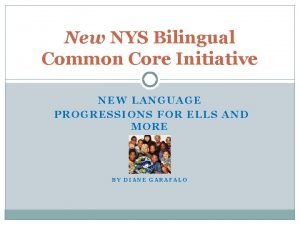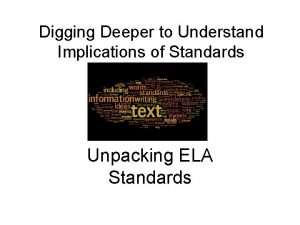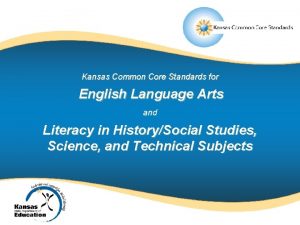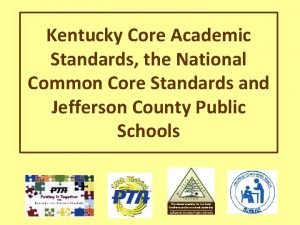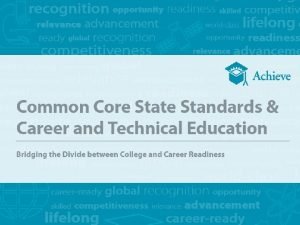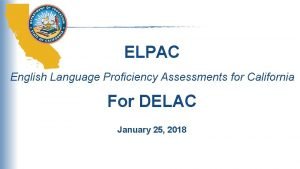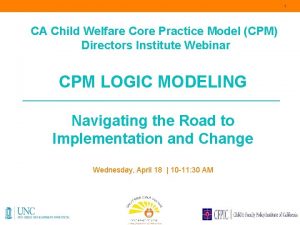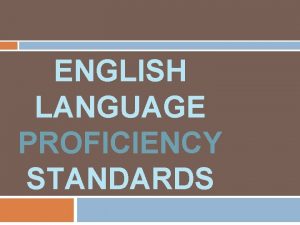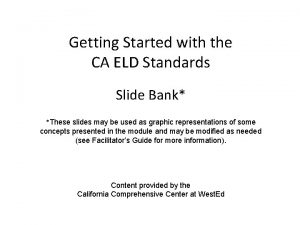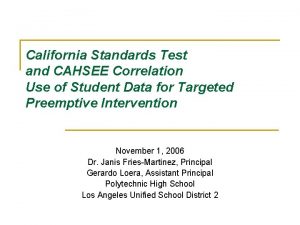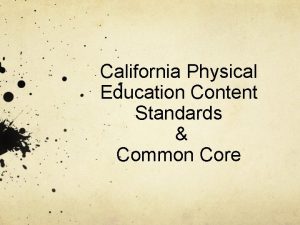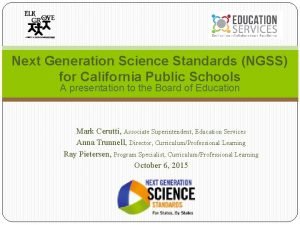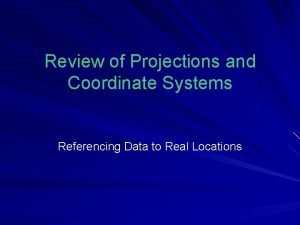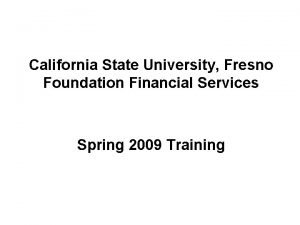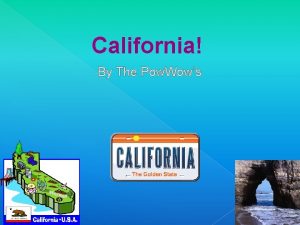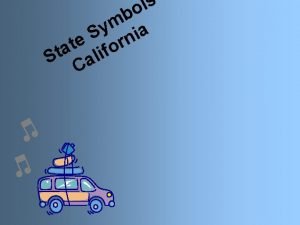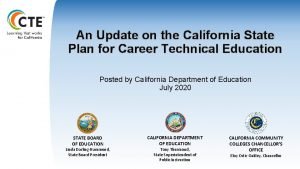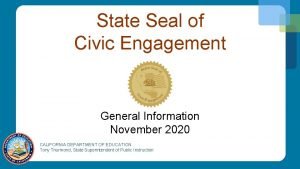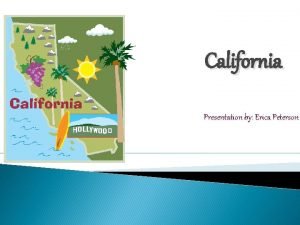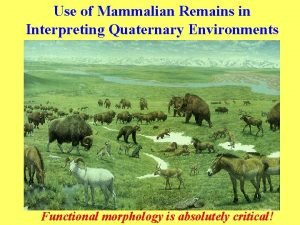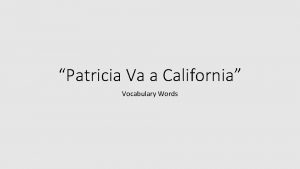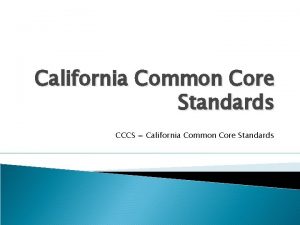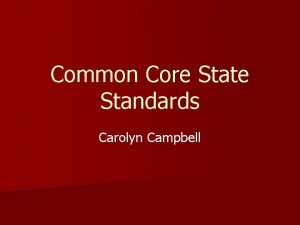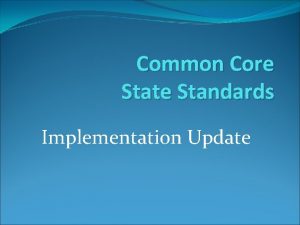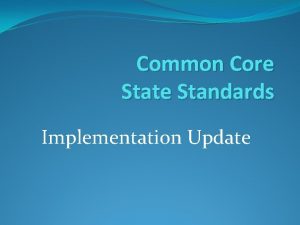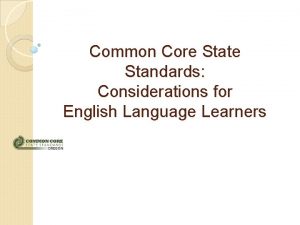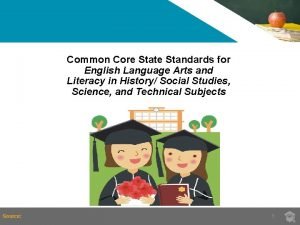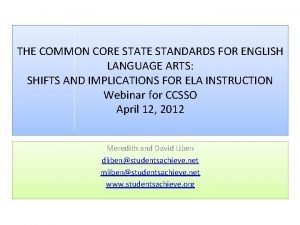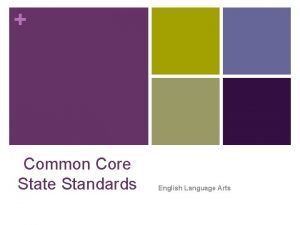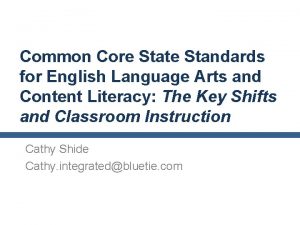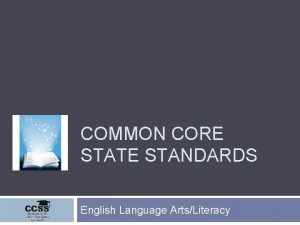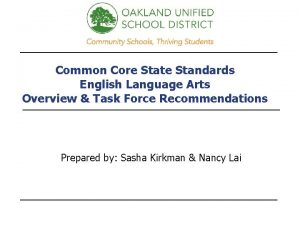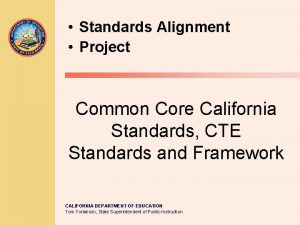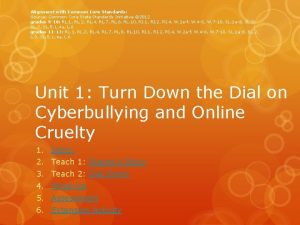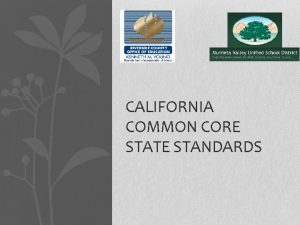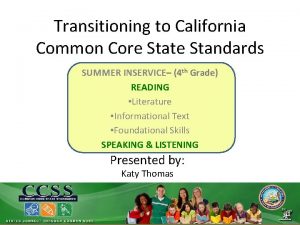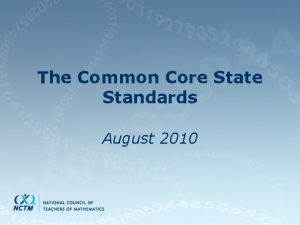CALIFORNIA COMMON CORE STATE STANDARDS FOR English Language
































- Slides: 32

CALIFORNIA COMMON CORE STATE STANDARDS FOR English Language Arts and Literacy in History/Social Studies & Science/Technical Subjects Steve Sinclair – ELA Coordinator • Steve Sinclair, ELA Coordinator • Sandra–Yellenberg, Sandi Yellenberg Science Coordinator

A Word from Sally Hampton 2

CCSS Overarching Goals 3 Ensure that our students are: Meeting college and work expectations; Provided a vision of what it means to be a literate person in the twenty-first century; Prepared to succeed in our global economy and society; and Provided with rigorous content and applications of higher knowledge through higher order thinking skills.

6

Benefits of the CCSS 5 Internationally benchmarked Expectations clear to students, parents, teachers, and the general public Allow for collaboration with other states on best practices, instructional materials, and professional development Costs to the state reduced Consistent expectations for all—not dependent on a zip code

6 CCSS Set Requirements for Both. . . English Language Arts (ELA) Reading Writing Speaking & Listening Language Literacy in History/Social Studies & Science and Technical Subjects K-5: Embedded in ELA 6 -12: Separate section (Reading & Writing only)

Similar Domains/Strands 7 California Domains • Reading • Writing • Listening and Speaking Common Core Strands • Reading • Writing • Speaking and Listening (ELA only) • Written and Oral English Language • Language (ELA only) Conventions

Shifts 8 California Standard Domain Vocabulary Reading Common Core Strand Language Convention Written and s/ Oral English Grammar Language Conventions Language

Key Advances of CCSS 9 Greater clarity and coherency across grade spans

Standards Viewed in Grade Spans 10

Strand Organization 11 Subheadings are consistent across grade levels within each set of standards.

Table Talk 12 Review the standards comparison matrix at your tables. Compare the CCCS to the California Standards. What do you notice?

Key Advances of CCSS 13 Greater clarity and coherency across grade spans Reading q Attention to text complexity

14 3 Factors to Measure Text Complexity e v i t ta i l a u Q Qu an tita Reader and Task tiv e

Text Complexity 14 Reading standards place equal emphasis on the sophistication of what students read and the skill with which they read. Standard 10 defines a grade-by-grade “staircase” of increasing text complexity that rises from beginning reading to the college and career readiness level. 15

Key Advances of CCSS 16 Greater clarity and coherency across grade spans Reading q Attention to text complexity q Balance of literature and informational texts

NAEP Alignment in Reading 17 Grade 4 8 12 Literature 50% 45% 30% Information 50% 55% 70% Percentages do not imply that high school ELA teachers must teach 70% informational text; they demand instead that a great deal of reading should occur in other disciplines.

NAEP Alignment in Writing 18 Three mutually reinforcing writing capacities: To persuade To explain To convey real or imagined experience Grade Persuade Explain 4 30% 35% Convey Experience 35% 8 35% 30% 12 40% 20%

K-5: Tools Dominate 19 Science Reading Writing Language Social Studies Math Literature

6 -12: Disciplines Dominate 20 Science Reading Writing Language Social Studies Math Literature

Integrated Model of Literacy 21 Science Reading Writing Language Social Studies Math Literature

22 Integrated Model of Literacy 7 th Grade Reading English Language Arts Determine an author’s point of view or purpose in a text and analyze how the author distinguishes his or her position from that of others. History/Soci Identify aspects of a text that reveal an author’s al Studies point of view or purpose (e. g. loaded language, inclusion or avoidance of particular facts). Science and Analyze the author’s purpose in providing an Technical explanation, describing a procedure, or Subjects discussing an experiment in a text

Key Advances of CCSS 23 Greater clarity and coherency across grade spans Reading q Attention to text complexity q Balance of literature and informational texts Writing q Emphasis on argument and informative/explanatory writing

24 Streamlined Writing Applications CA Standards: CCSS: q q Write Opinions (K-5); Arguments (6 -12) q q q Informative/ Explanatory Texts Narratives q q q q Narratives Expository Descriptions Friendly Letters Personal or Formal Letters Response to Literature Information Reports Summaries Persuasive Letters/Compositions Research Reports Fictional Narratives Biographical/Autobiographical Narratives Career Development Documents Technical Documents Reflective Compositions Historical Investigation Reports Job Application/Resume

Key Advances of CCSS 25 Greater clarity and coherency across grade spans Reading q Attention to text complexity q Balance of literature and informational texts Writing q Emphasis on argument and informative/explanatory writing Speaking and Listening q Inclusion of formal and informal talk

Collaborative Conversations 26 Speaking and Listening, Grade 5 1. Engage effectively in a range of collaborative discussions (one-on-one, in groups, and teacher-led) with diverse partners on grade 5 topics and texts, building on others’ ideas and expressing their own clearly. a) Come to discussions prepared, having read or studied required material … a) b) Follow agreed-upon rules for discussions and carry out assigned roles. Pose and respond to specific questions by making comments that contribute to the discussion and elaborate on the remarks others. . . 26

Key Advances of CCSS 27 Greater clarity and coherency across grade spans Reading q Attention to text complexity q Balance of literature and informational texts Writing q Emphasis on argument and informative/explanatory writing Speaking and Listening q Inclusion of formal and informal talk Integrates media sources across the standards

Integrating Media Sources 28 Reading Standards for Informational Text, Grade 6 7. Integrate information presented in different media or formats (e. g. , visually, quantitatively) as well as in words to develop a coherent understanding of a topic or issue. Writing Standards, Grade 6 6. Use technology, including the Internet, to produce and publish writing a well as to interact and collaborate with others; demonstrate sufficient command of keyboarding skills to type a minimum of three pages in a single sitting. 28

In sum. . . 29 All Teachers will need to § § § ELA Teachers will need to § q Scaffold comprehension of increasingly Complex Texts Integrate Media Sources into instructional activities Support/monitor Informal Talk Teach how a wide variety of genres fall into three big buckets: Expository, Persuasive, and Narrative Science and History Teachers will need to § Teach Reading and Writing strategies in their content areas explicitly

30 What are the implications for PD? At your tables, discuss the Professional Development priorities for supporting teachers in integrating the new Common Core State Standards.

Web Resources 31 National Standards www. corestandards. org California Standards http: //www. cde. ca. gov/be/st/cc/index. asp Curriculum Maps: http: //commoncore. org/maps/index. php Crosswalks: http: //www. ccsesa. org/resources/zz%20 K 12%20 ELA_Croswalks%20080410. pdf Interview with Sally Hampton http: //www. americaschoice. org/commoncorestandardsreso urces? gclid=CNe. B 3 oi 0 xq. MCFRBTagod. JRCw. Xw

Contact Information 32 If you have any questions about Core Standards - and what type of training would best help your teachers make the shift to them, please feel free to contact: § Steve Sinclair ELA Coordinator Steve_sinclair @sccoe. org § Sandi Yellenberg Science Coordinator sandra_yellenberg@saccoe. org
 California content standards english
California content standards english Pa common core standards
Pa common core standards Common core state standards ct
Common core state standards ct Common core state standards missouri
Common core state standards missouri Common core standards arkansas
Common core standards arkansas California state standards physical education
California state standards physical education English content standards
English content standards Common core standards georgia
Common core standards georgia Bilingual common core progressions
Bilingual common core progressions Unpacking the standards template
Unpacking the standards template Ela standards kansas
Ela standards kansas Common core standards kentucky
Common core standards kentucky Common career technical core
Common career technical core Elpac proficiency levels
Elpac proficiency levels Cpm implementation
Cpm implementation Language english
Language english Texas english language proficiency standards
Texas english language proficiency standards Oelpa
Oelpa Bridging emerging expanding
Bridging emerging expanding California standards test
California standards test California pe standards
California pe standards Next generation science standards california
Next generation science standards california California state plane zones
California state plane zones California state university long beach nursing
California state university long beach nursing California state university fresno foundation
California state university fresno foundation California's state motto
California's state motto California state animal
California state animal State of california dgs
State of california dgs California state plan
California state plan State seal of civic engagement
State seal of civic engagement California state animal
California state animal California state fossil
California state fossil Patricia va a california chapter 1 english translation
Patricia va a california chapter 1 english translation
